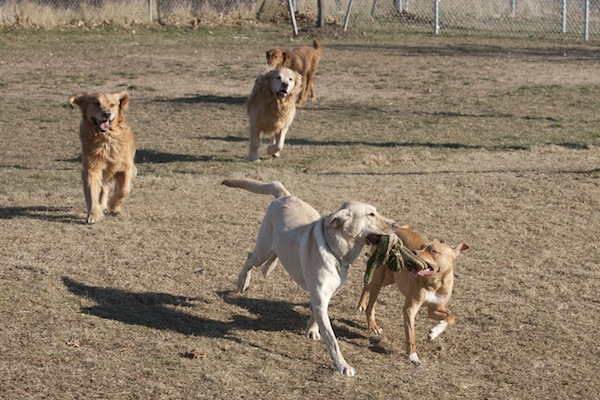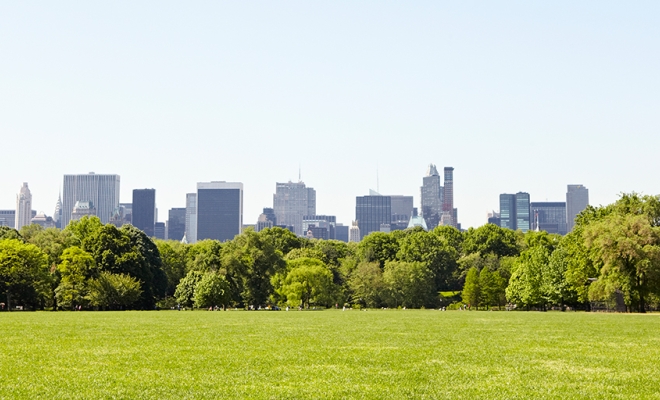
Imagine a place where dogs run freely together, playfully romping on fresh green grass. Where canines of myriad breeds share the same water fountain while their owners exchange ideas. A place that’s clean, accessible, popular, safe.
While it may sound like dog heaven, this is actually a common description of a dog park—designated off-leash areas where canines can get much-needed exercise and socialization time while their owners trade tips on everything from training to proper nutrition. And following a national trend, they’re sprouting up all across Long Island.
“We’ve seen a really big increase in dog parks on Long Island, both in Nassau and Suffolk counties, over the last five or six years,” says Ginny Munger Kahn, president of nonprofit LI-Dog Owners Group. “It’s been the result of collaborations between organizations of dog owners and elected officials and parks department officials.”
Currently Nassau has 10 dog parks and Suffolk has 11, she adds. Just six years ago Suffolk had only one. Just within the past year, three new dog parks opened in Nassau County: in Valley Stream, Massapequa and Eisenhower Park. And more are set to open in both counties.
Supporters point to several reasons why dog parks are gaining ground.
Advocates contend that dog parks provide much-needed open space for those owners who may otherwise not have adequate backyards for their pets to roam in.
“There’s a lot of people that can’t exercise their dogs off-leash, especially the elderly, and it’s a great way to exercise your dogs,” says dog trainer Dawn Bennett.
Another major benefit, they say, is that socialization and exercise have been known to positively impact a dog’s behavior.
“People talk about how they see their dog’s behavior change for the better because they are getting adequate exercise at a dog park,” says Munger Kahn. “Over the last ten years it’s become common knowledge that dogs need exercise and socialization.”
Additionally, Kahn points out, dog parks are great place for owners to meet like-minded people.
“They build communities,” she says. “Many of my best friends I’ve met through the dog park.”
There’s definitely a need here on Long Island. Dogs are only permitted in Suffolk County parks if they are on a leash, she explains. In Nassau, no dogs are allowed in county parks—leashed or unleashed. Most town parks across Long Island carry the same or similar rules.
“I adopted a dog and realized that there is no place to walk your dog in parks or take her off leash,” says Peggy Heijmen, an Oyster Bay resident, dog owner and nonprofit LI-Dog Owners Group board member. “It’s very, very difficult.”
The group, founded in 1998, is dedicated to increasing public parkland for Long Island dog owners and their four-legged companions. Their efforts are paying off. Heijmen was the driving force behind the Massapequa dog park.
“We went to several town board meetings and did petitions and wrote letters to get this park running and successful,” she says.
Opened in June 2012 on Louden Avenue, the park features such amenities as doggie water fountains and separate areas for small and large dogs.
“It has been incredibly successful,” she continues. “We have a Facebook page so that people can share their pictures and their experiences, and we have over 200 people actively using the page.”
The Valley Stream dog park opened a month prior, mainly the brainchild of the Friends of Valley Stream Dog Park, an all-volunteer group organized to support and provide facilities to local dog owners.
President Richard Infield says the project went off without a hitch after receiving the support of the Valley Stream Mayor Edwin Fare and other members of local government.
“Once we started, it was very much a team effort between us and the village,” he says. “It’s really been an easy relationship and continues to be.”
UNLEASHED
Government officials and dog park proponents have been joining forces to open more spaces in Suffolk County, too. In July a dog park in Calverton opened under the guidance of Riverhead Town Councilman Jim Wooten and nonprofit Move the Animal Shelter (MTAS).
“We initiated the Calverton dog park to address the needs of our senior community, who live in modular homes or smaller lots,” says Woonten. “It gives their pets a chance to run about and play and socialize with other dogs.”
MTAS secured funding for the park, he adds, which along with private donations of benches and fencing, helped keep the cost down for taxpayers. After all, it’s the startup costs that can pose hurdles. Lack of funding was one of the obstacles Bennett faced when she tried to secure a bigger dog park in Southold, she says.
“I had come back from California and I was blown away with how many dog parks were there and how dog-friendly they were,” explains Bennett. “And here, where we live, the only off-leash area we had was this pitiful, very barren quarter of an acre dog park that wasn’t used by anybody.
Bennett and her business partner Asha Gallacher, who together run the North Fork School for Dogs, decided to create a petition for their cause. After two months, the duo collected about 500 signatures.
“I just put the petitions in every store,” Bennett says. “We collaborated with all the pet stores and the animal shelter. The squeaky wheel gets the oil—I just went to every town meeting and got all the petitions together.”
While the request to build a new park was ultimately denied, officials agreed to expand upon an existing dog park. The environmental nonprofit Group for the East End donated trees for shade, and the town installed benches. After a year, the park was completely overhauled and is now more than an acre in size and full of people and dogs every weekend.
Bennett is grateful for the help from Southold Town Supervisor Scott Russell.
“He was very corporative and he was a big help,” she says. “He listened. Even though we had a strict budget, he gave us a piece of the recreational pie.”
PUPPY LOVE
Dog parks aren’t just gaining popularity here on Long Island. According to data from the Trust for Public Land’s 2011 City Park Facts, dog parks in major U.S. cities jumped 34 percent over the last five years. In comparison, parks overall only increased 3 percent during that time.
“This is not unique to Long Island,” says Munger Kahn. “There’s a tremendous demand for these areas, and a love for them.
“They are now what the playground movement of the 1950s was,” she adds.
So far, Long Island’s new dog parks have garnered so much positive reception that more are in the works. In Suffolk, the LI-Dog Owners Group is working on a campaign to build a second dog park in Centereach with Town of Brookhaven Councilwoman Kathleen Walsh. Councilman Wooten also hopes to create another dog park this spring at Stotzy Park in Riverhead. In Nassau, Heijmen is now looking to add more dog parks in the Town of Oyster Bay.
Besides the additional parks, owners also seek more on-leash access in both counties’ parks.
“A lot of people exercise with their dogs,” says Munger Kahn. “Dog walking is their primary form of exercise. At most Long Island town parks you’re not allowed to even walk your dog on a leash. So dog owners are regulated to walk on the sidewalks in the neighborhoods that have them or in the street, and it’s dangerous.”
Munger Kahn says the main criticism against this is concern about people not picking up after their dogs. Yet with increased access, she says, comes increased accountability among responsible dog owners. And that can only lead to more access for dog lovers.
“We understand by asking for more access it means we have to be responsible. We have to pick up after our dogs,” she says. “I am confident that as long as the majority of us dog owners are responsible and pick up after our dogs that we will continue to see improvement in gaining access to public park land.”
“I think that as more dog parks have been developed, elected officials have seen how successful and popular they are,” she adds.
It’s a sentiment Councilman Wooten shares.
“Dog parks are a wonderful thing,” he says.
































